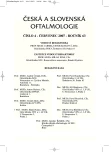-
Medical journals
- Career
Analysis of Movement Disorders Surgeries at the Department of Ophthalmology, the FNKV Hospital, Prague, Czech Republic, during the Ten-Years Period
Authors: J. Krásný; R. Brunnerová; J. Syslová; J. Ciprychová *; Čeledová
Authors‘ workplace: Ortoptistky pracující v průběhu desetiletého období na Oční klinice FNKV, Praha *; J. , Modlingerová E. Oční klinika FN Královské Vinohrady, Praha přednosta prof. MUDr. P. Kuchynka, CSc. *
Published in: Čes. a slov. Oftal., 63, 2007, No. 4, p. 249-261
Overview
The authors analyzed medical records of 1644 surgeries of strabismus and ptosis performed during the ten-years period (1997–2006). The surgeries were divided into three groups according to the age of the patients: 531 surgeries were performed in patients until the age of 6 years, 508 surgeries were in children aged 7–18 years, and the study included also 605 operative procedures in adult patients aged 19 years and older. The strabismus operations formed 1401 single or multi-phases surgeries and the ptosis correction was performed in 243 patients. The most common surgical procedures in strabismus were weakening or strengthening procedures on the horizontal muscles (65 %). Out of the weakening procedures, the authors positively preferred the adjustable partial myotomy acc. Gonin-Hollwich, which formed 51 % of surgeries on horizontal muscles. The very favorable results underlined the importance of this type of surgery in congenital esotropia, Duane syndrome I., and in excess of divergence. This surgical technique was also used as a weakening procedure as a part of the Kestenbaum procedure in the treatment of torticollis in horizontal nystagmus. The solely surgery on oblique or vertical muscles was performed in 16 %, and the most common operative procedure was the retro-position of the lower oblique muscle acc. to Parkes, and on the second place, there was its partial myotomy with electro-cautery acc. to Romer-Martinez. The weakening procedures were used together on the horizontal and oblique muscles in 10 %. Different surgical procedures, including the transposition’s ones, were indicated in external ocular muscles palsies and torticollis. Altogether they formed 12 % of all strabismus surgeries. The most common procedure to treat the ptosis in children and teenagers was the fronto-tarsal suspension acc. to Fox (51 %), and in adults, it was the tarso-resection of the upper eyelid acc. to Fasanella (74 %).
Key words:
strabismus surgery, surgery for ptosis, partial myotomy acc. to Gonin-Hollwich
Labels
Ophthalmology
Article was published inCzech and Slovak Ophthalmology

2007 Issue 4-
All articles in this issue
- Effect of the Mixture of Timoptol and Amino Acid Taurine in the Bioregulation of the Intraocular Pressure in Rabbits
- Evaluation of Glaucoma Progression by Means of HRT II Results
- EPI-LASIK – 2 Years’ Clinical Results
- Analysis of Movement Disorders Surgeries at the Department of Ophthalmology, the FNKV Hospital, Prague, Czech Republic, during the Ten-Years Period
- Macular Edema after an Uncomplicated Cataract Surgery
- Macular Edema after Cataract Surgery in Diabetic Patients without Retinopathy
- Clinical Results of the Aphakia Correction by Means of Secondary Implantation of the Iris-Fixated Anterior Chamber Intraocular Lens
- FiveYears Retrospective Study of Latanoprost Glaucoma Treatment
- Czech and Slovak Ophthalmology
- Journal archive
- Current issue
- Online only
- About the journal
Most read in this issue- Macular Edema after an Uncomplicated Cataract Surgery
- Clinical Results of the Aphakia Correction by Means of Secondary Implantation of the Iris-Fixated Anterior Chamber Intraocular Lens
- Analysis of Movement Disorders Surgeries at the Department of Ophthalmology, the FNKV Hospital, Prague, Czech Republic, during the Ten-Years Period
- Evaluation of Glaucoma Progression by Means of HRT II Results
Login#ADS_BOTTOM_SCRIPTS#Forgotten passwordEnter the email address that you registered with. We will send you instructions on how to set a new password.
- Career

